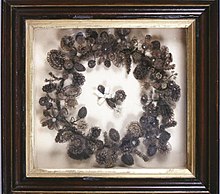
A hairstyle, hairdo, haircut, or coiffure refers to the styling of hair, usually on the human head but sometimes on the face or body. The fashioning of hair can be considered an aspect of personal grooming, fashion, and cosmetics, although practical, cultural, and popular considerations also influence some hairstyles.
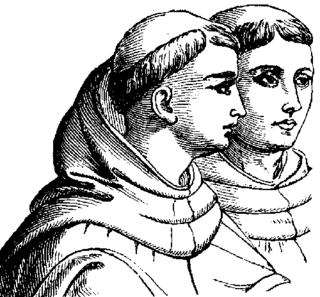
Tonsure is the practice of cutting or shaving some or all of the hair on the scalp as a sign of religious devotion or humility. The term originates from the Latin word tonsura and referred to a specific practice in medieval Catholicism, abandoned by papal order in 1972. Tonsure can also refer to the secular practice of shaving all or part of the scalp to show support or sympathy, or to designate mourning. Current usage more generally refers to cutting or shaving for monks, devotees, or mystics of any religion as a symbol of their renunciation of worldly fashion and esteem.

Dreadlocks, also known as dreads or locs, are a hairstyle made of rope-like strands of hair. Dreadlocks are created by either manually twisting the hair or by allowing it to mat naturally. Over time, the hair will form tight braids or ringlets.
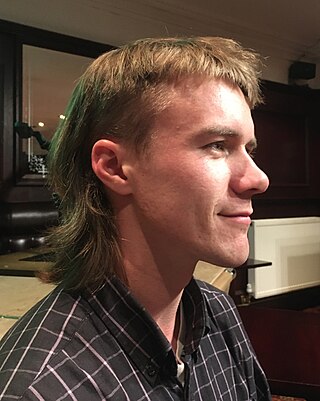
The mullet is a hairstyle in which the hair is cut shorter at the front, top and sides, but is longer at the back.

The afro is a hair style created by combing out natural growth of afro-textured hair, or specifically styled with chemical curling products by individuals with naturally curly or straight hair. The hairstyle can be created by combing the hair away from the scalp, dispersing a distinctive curl pattern, and forming the hair into a rounded shape, much like a cloud or puff ball.

Polish plait, less commonly known in English as plica or trichoma, is a particular formation of hair. This term can refer to either a hairstyle or a medical condition, depending on context. The term is connected to a system of beliefs in European folklore, and healing practices in traditional medicine in medieval Polish–Lithuanian Commonwealth that believed matted hair was an amulet, or a catchment or trajectory for illness to leave the body.

A French braid, also called a French plait, is a type of braided hairstyle. The three-strand gathered plait includes three sections of hair that are braided together from the crown of the head to the nape of the neck.

An induction cut, also referred to as a mighty fine, is the shortest possible hairstyle without shaving the head with a razor. The style is so named as it is traditionally the first haircut given to new male recruits during initial entry into many of the world's armed forces, but most particularly in the United States.

The first haircut for a human has special significance in certain cultures and religions. It can be considered a rite of passage or a milestone.

Bangs or a fringe are strands or locks of hair that fall over the scalp's front hairline to cover the forehead, usually just above the eyebrows, though can range to various lengths. While most modern Western hairstyles cut the bangs straight, they may also be shaped in an arc or left ragged.

Long hair is a hairstyle where the head hair is allowed to grow to a considerable length. Exactly what constitutes long hair can change from culture to culture, or even within cultures. For example, a woman with chin-length hair in some cultures may be said to have short hair, while a man with the same length of hair in some of the same cultures would be said to have long hair.
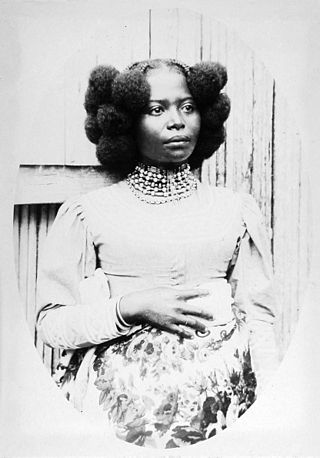
Kinky hair, also known as afro-textured hair, is a human hair texture prevalent in the indigenous populations of many regions with hot climates, mainly Sub-Saharan Africa and some areas of Melanesia, and Australia. Each strand of this hair type grows in a repeating pattern of small contiguous kinks which can be classified as tight twists and sharp folds. These numerous kinks make kinky hair appear denser than straight, wavy, and other curly hair types.

Synthetic dreads, also called dread extensions, dread falls, and cyberlocks, are interlocked coils of synthetic hair, mostly kanekalon, that give the look and feel of natural dreadlocks without the commitment or maintenance. They are mainly worn as a fashion statement for the subculture of cybergoth.

Hairstyle fashion in Rome was ever changing, and particularly in the Roman Imperial Period there were a number of different ways to style hair. As with clothes, there were several hairstyles that were limited to certain people in ancient society. Styles are so distinctive they allow scholars today to create a chronology of Roman portraiture and art; we are able to date pictures of the empresses on coins or identify busts depending on their hairstyles.

African-American hair or Black hair refers to hair types, textures, and styles that are linked to African-American culture, often drawing inspiration from African hair culture. It plays a major role in the identity and politics of Black culture in the United States and across the diaspora. African-American hair often has a kinky hairy texture, appearing tightly coiled and packed. Black hair has a complex history, culture, and cultural impact, including its relationship with racism.
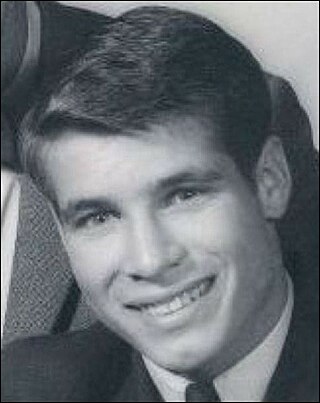
A regularhaircut in Western fashion is a men's and boys' hairstyle featuring hair long enough to comb on top, with a defined or deconstructed side part, and back and sides that vary in length from short, semi-short, medium, long, to extra long. The style is also known by other names including taper cut, regular taper cut, side-part and standard haircut; as well as short back and sides, business-man cut and professional cut, subject to varying national, regional, and local interpretations of the specific taper for the back and sides.

The czupryna, also known as the Polish halfshaven head, is a traditional Polish noble haircut, associated mainly with Sarmatism, but worn by Poles in the Middle Ages too. It is marked by shaving hair above the ears and on the neck at the same height, with longer hair on the top of the head. For hundreds of years it was typical of Poles.

Box braids are a type of hair-braiding style that is predominantly popular among African people and the African diaspora. This type of hairstyle is a "protective style" and is "boxy", consisting of square-shaped hair divisions. Box braids are generally installed by using synthetic hair which helps to add thickness as well as helping the natural hair that is in the braid. Because they are not attached to the scalp like other similar styles such as cornrows, box braids can be styled in a number of different ways. The installation process of box braids can be lengthy, but once installed they can last for six to eight weeks. They are known for being easy to maintain.

A Lovelock was popular amongst European "men of fashion" from the end of the 16th century until well into the 17th century. The lovelock was a long lock of hair, often plaited (braided) and made to rest over the left shoulder to show devotion to a loved one.

Braids are a complex hairstyle formed by interlacing three or more strands of hair. Braiding has been used to style and ornament human and animal hair for thousands of years in various cultures around the world.
